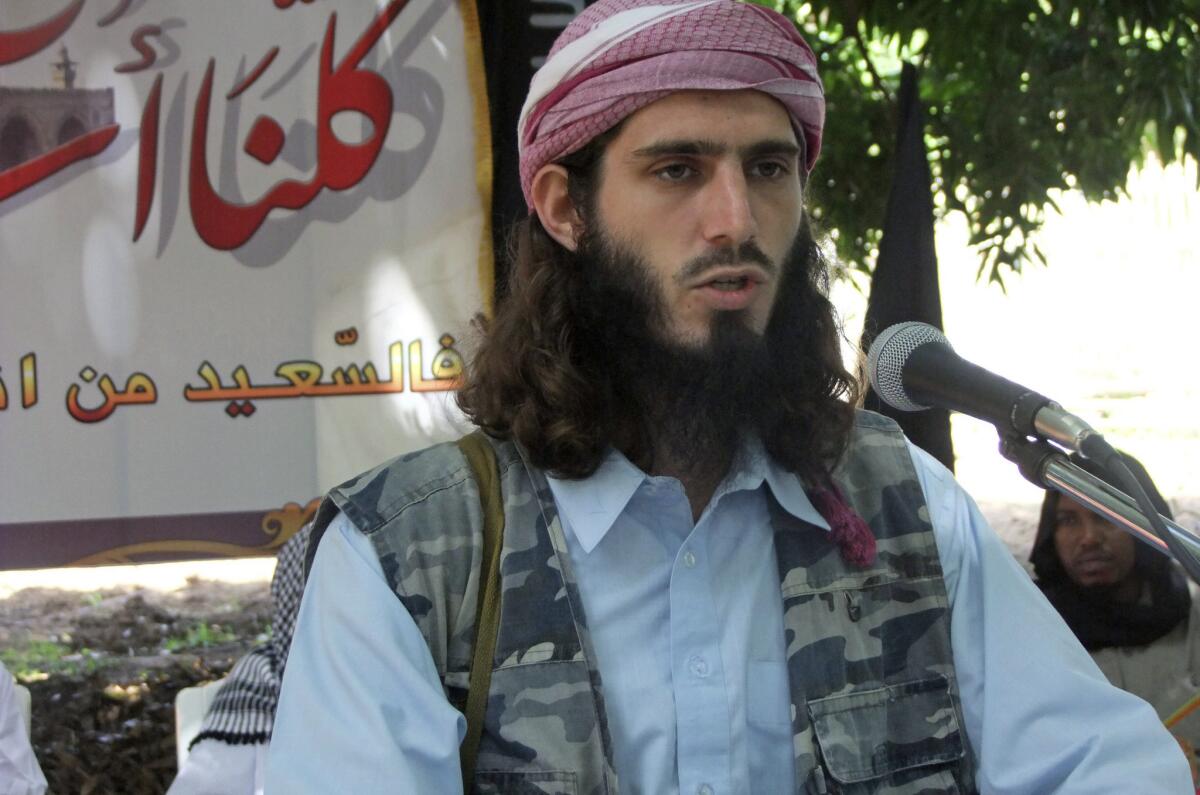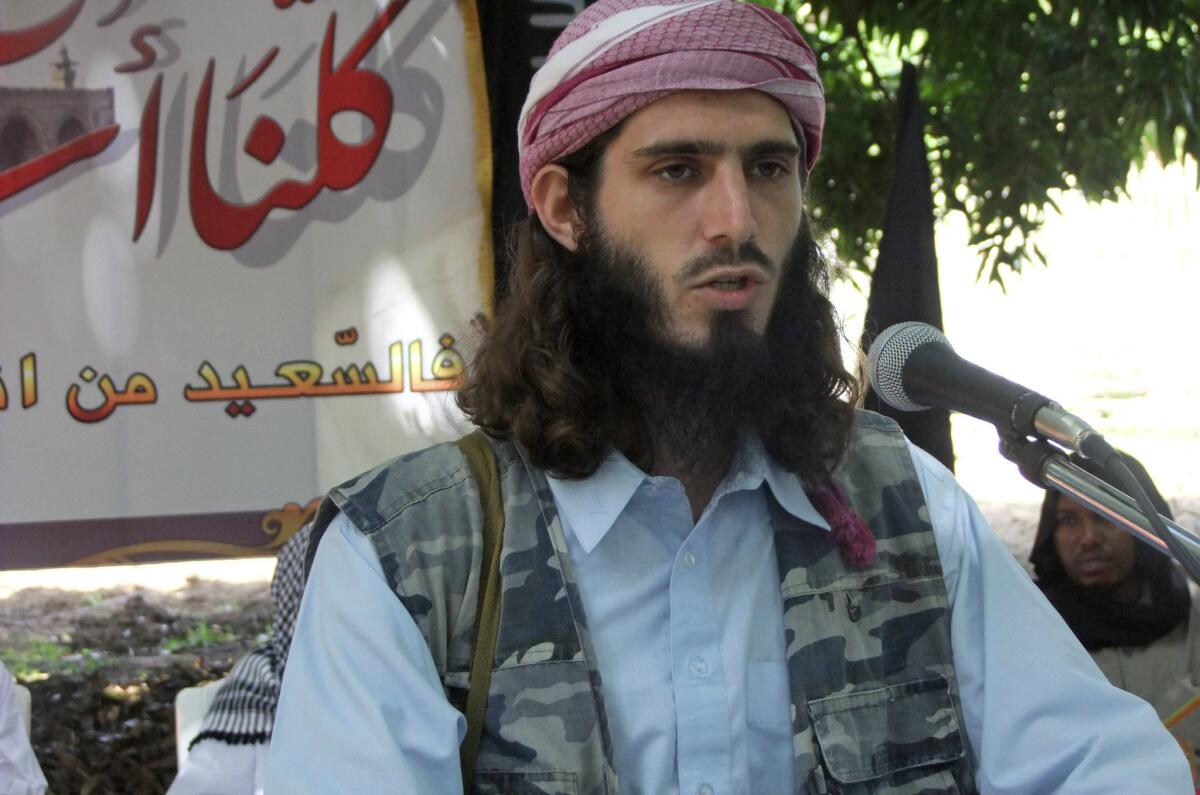Review: What drives Americans to join the jihad? The book ‘United States of Jihad’ explains

American-born Omar Hammami in Somalia in 2011.
Consider the case of Omar Hammami: Born in Alabama to a Syrian Muslim father and American Baptist mother, he attended Bible studies on Sundays and was in the gifted program at his high school. He then made a long intellectual and temporal journey — from Alabama to Toronto to Egypt and then Somalia — to fight with al-Shabaab, Al Qaeda’s Somali affiliate. Hammami released jihadist agitprop hip-hop singles online with song titles like “Send Me a Cruise [Missile]” and “Make Jihad with Me.” A prolific user of Twitter, Hammami referred to people as “homie” and name-dropped Tupac Shakur, not unlike any American rap fan.
In “United States of Jihad” Peter Bergen, a vice president of the New America Foundation and one of America’s most prominent terrorism experts, makes a compelling and often unsettling case that, in the years since Sept. 11, 2001, Islamist terrorism in the United States has metamorphosed. Worries about “sleeper cells” operating under the hierarchical, elitist model of organizations like Al Qaeda have been overshadowed by the domestic threat from diffuse networks and virtual, online communities of like-minded jihadists.
These “lone wolves” may not have the capacity or training to inflict terror on the scale of 9/11, but they are menacing nonetheless. We knew this before the December attack in San Bernardino, during which Syed Rizwan Farook and Tashfeen Malik shot and killed 14 people at a county employee holiday party, but that event underlined the changing nature of domestic Islamist terrorism. While Bergen completed his book before the San Bernardino attacks, his exploration of the environment in which individuals such as Farook and Malik operate helps shed light on this newer, “leaderless” form of jihadist violence.
However, as Bergen shows, the transformation of domestic jihadism has not only dispersed the Islamist terrorist threat but in a perverse process of cultural intermingling has partly Americanized jihad itself. The “soft power” appeal of American culture is often considered to be one of this country’s most enduring assets, but the new admixture of jihadi terror and pop culture savoir faire potentially turns this idea on its head.
In addition to Hammami, Bergen provides many examples of this phenomenon, which often appears like an especially gruesome farce. Take the case of Hoda Muthana, a college undergraduate who left her home in Birmingham, Ala., (yes, also Alabama) to join the Islamic State. Tweeting from Syria, Muthana posted pictures of herself (completely veiled, of course) “holding an AK-47 ... on top of a fancy white BMW with the caption ‘chillin in the Khilafa [caliphate].’”
Or take the story of Samir Khan, who grew up in the suburbs of New York City, traveled to Yemen to join Anwar Awlaki — then the leader of Al Qaeda in the Arabian Peninsula, and himself an American citizen — and founded Al Qaeda’s first English-language publication. He named it Inspire. The magazine featured articles such as “Make a Bomb in the Kitchen of Your Mom.”
The American jihadists profiled in the book — who are white, black, Middle Eastern and Asian, and Muslims by birth as well as conversion — are a motley bunch, as variegated by ethnicity, class and region as America itself.
Some, like Samir Khan and Anwar Awlaki, have been killed by U.S. forces (together, in Yemen in 2011) as part of the war on terror; others, like Hammami, have met their end at the hands of their erstwhile jihadist allies. (Hammami — perhaps neglecting to consider that protections of speech are less rigorously adhered to in Somalia than in the United States — was killed by al-Shabaab leaders after repeatedly criticizing them on Twitter. In another very American innovation, Hammami also live-tweeted what became his execution.)
Many of the people profiled by Bergen seem motivated by the potential for military glory or adventure, others by basic carnal rewards. Most come off as deeply puerile, jihadist Holden Caulfields, rejecting the banalities of American life and seeking refuge in a system of complete intellectual security.
What these men and women often have in common, though, is their emergence from an American cultural milieu they are simultaneously rejecting and appropriating for their own ends.

In this Wednesday, May 11, 2011 file photo, American-born Islamist militant Omar Hammami addresses a press conference of the militant group al-Shabab at a farm in southern Mogadishu’s Afgoye district in Somalia.
How successful have they been in this process? The evidence here should make us cautiously optimistic. According to Bergen’s findings, since 9/11, a mere 330 people have been charged in the United States with crimes related to jihadist terror — from attempting to join a group abroad or plan a domestic attack, to financing terrorist networks. four out of five of these individuals are American citizens or permanent residents.
Now, these are not entirely insignificant numbers, but they need to be put in perspective. The nature of terrorism, of course, is such that a small number of determined individuals can cause mass casualty events, so these threats must be treated with deadly seriousness. But what that should actually entail in terms of expenditures in blood and national treasure, and how much of our precious, fragile “open society” we are willing to forfeit in that fight, is a properly political question that deserves to be adjudicated in public, soberly. Nearly 15 years after the 9/11 attacks, many in Washington seem unable or unwilling to respect the American people enough to speak to them like adults.
While acknowledging the real threat that “Binladenism,” as he calls it, poses to American interests abroad and security at home, Bergen takes a generally skeptical view of the growth of the post-9/11 national security state and of the fear-mongering about Islam that has increasingly transfixed the darker crannies of American politics. This skepticism, I think, is not only strategically and morally sound but also borne out by the facts.
For example, according to data assembled under Bergen at the nonprofit public policy institute New America Foundation, since 9/11 jihadists have killed 45 people in the United States. During this same period, right wing extremists of various stripes — such as antigovernment and anti-abortion fanatics — have been responsible for 48 deaths domestically. (Before the jihadist attack in San Bernardino, the count was 31 to 48 — not even close.)
This points to a major tension in the book. The United States is an exceedingly violent place by the standards of all other developed countries, and, given the litany of cultural pathologies (entrenched multigenerational poverty, systemic racism, lax gun laws, to name but a few) that drive this violence, jihadism is, in this sense, really the least of our worries. Indeed, as Bergen writes, from 2003 to ‘10, 88,000 Americans were killed by guns; in the post-9/11 era, jihadists have killed 45 people in the United States. For all their manifest evil, Farook and Malik — perpetrators of the single deadliest instance of jihadist violence in the United States since 2001 — killed 14.
Bergen is clearly aware of this gap between perception and reality, but he saves almost all of his reflections on the matter until the last chapter, which serves to retrospectively color the rest of the book. As he writes, correctly, “the extent to which our government and the media participate in this endemic paranoia is damaging in that, apart from doing the terrorists’ job for them, which is to terrorize, it helps crowd out more serious issues the planet faces. Climate change is far less telegenic than jihad.”
There is small but palpable irony in making this point in a book provocatively titled “United States of Jihad,” published at the beginning of an election year. I eagerly await a rush of equally high-profile work on right-wing antigovernment terrorism and a flood of bestsellers with titles like “United States of Disastrous Climate Change Deniers.” But I’m not holding my breath for their advent any time soon.
Dorfman is senior editor of “Ethics & International Affairs,” the journal of the Carnegie Council for Ethics in International Affairs, where he is also a senior fellow.
::
United States of Jihad: Investigating America’s Homegrown Terrorists
Peter Bergen
Crown: 400 pp., $28
More to Read
Sign up for our Book Club newsletter
Get the latest news, events and more from the Los Angeles Times Book Club, and help us get L.A. reading and talking.
You may occasionally receive promotional content from the Los Angeles Times.






